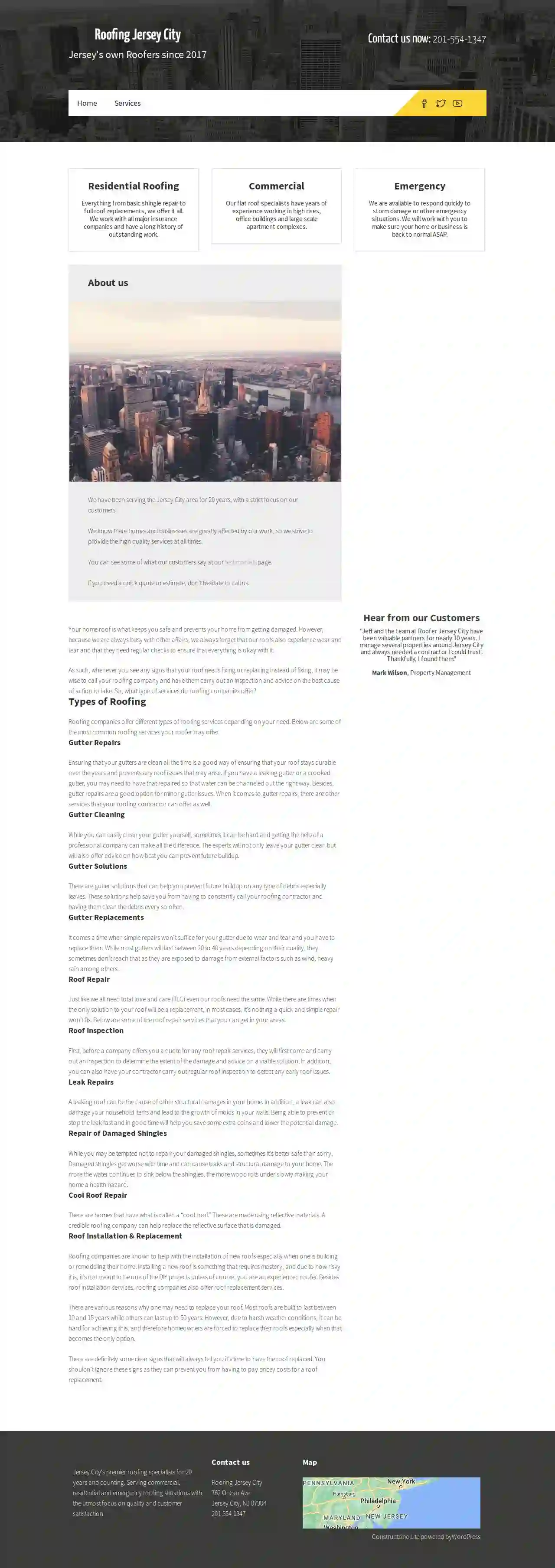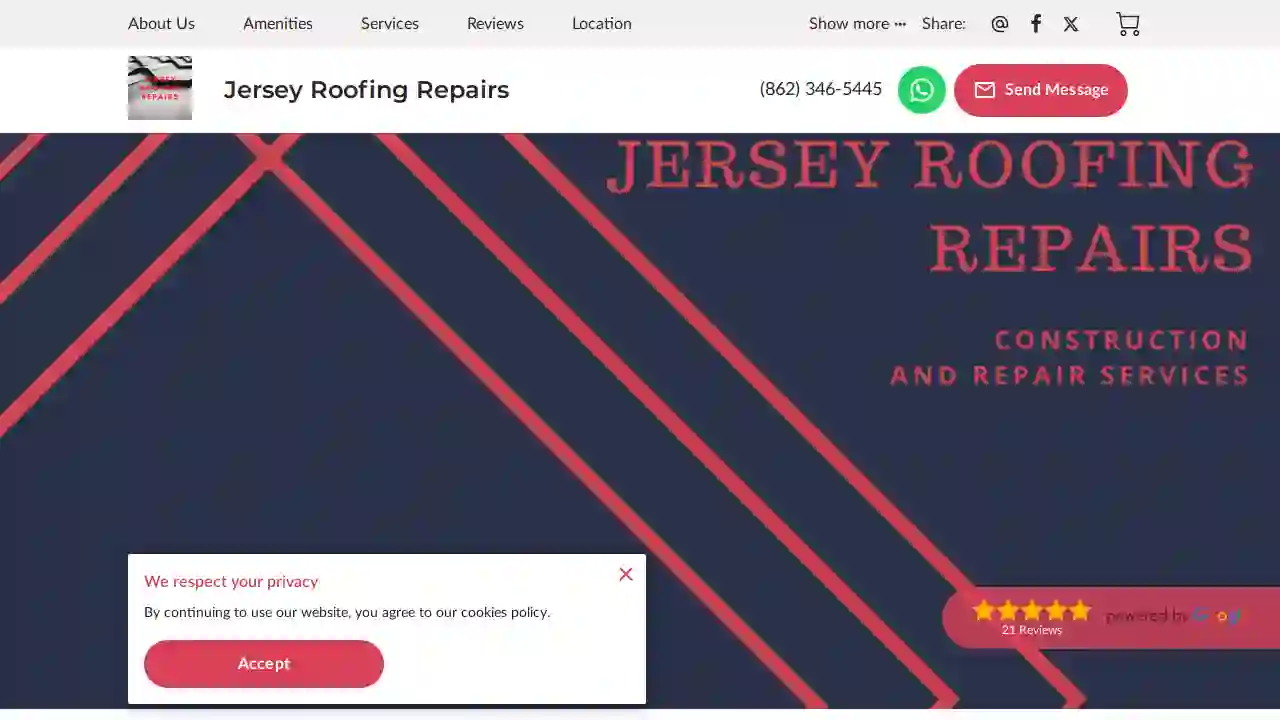Roofing Companies Jersey City
Top 10 Roofing Contractor in Jersey City
Get multiple Roofing Companies quotes for your project today! Compare profiles, reviews, accreditations, portfolio, etc... and choose the best offer.

Elite Roofing Contractor
5293 reviewsJersey City, NJ, 35 Hudson St, W 2812, 07302, USElite Roofing Contractor is a fully licensed and insured roofing company serving Hudson County for over 40 years. With a team of experienced professionals, we provide a comprehensive approach to roofing and specialize in a wide range of services. Our commitment to customer satisfaction has earned us a 5-star rating on Google and numerous testimonials from satisfied clients. We are proud to be a small company with a big reputation, and we look forward to serving you.
- Services
- Why Us?
- Accreditations
- Our Team
- Testimonials
- Gallery
Get Quote
Gaby Roofing Flat Roof Specialist
581 reviewsUnion City, 123 Main St, 07087, USGaby Roofing is a trusted local roofer in Union City, NJ, with over 20 years of experience in residential and commercial roofing. We pride ourselves in using the best roofing and siding materials paired with our expertise to ensure that every project is completed professionally, promptly, and proficiently. We offer premium roofing services, including flat roof installation, shingle roof installation, total roof replacement, flat roof repair, shingle roof repair, roof maintenance, and installing exterior vinyl siding. We are located in Union City and primarily serve North Jersey. We offer free roofing and siding estimates, which can be set up by calling Damian at 201-638-8556 or by filling out the web form in the Contact Page. Our Roofing Professionals are happy to bring roofing and siding samples directly to your home. We have developed major contractor relations with GAF and Owens Corning to provide the customer with the materials needed for the job - FAST. All roofing projects are not considered complete until the client is 100% satisfied. With Gaby Roofing, you can be assured that your roof will be leak and worry-free for 10+ years (manufacturer and labor warranty); SHINGLE jobs include a lifetime warranty. GABY ROOFING is the premier flat roof installer in New Jersey; ensure the lasting safety of the roof of your home or business with our trusted services, backed by a worry-free guarantee, and 20+ years of quality workmanship in the roofing business.
- Services
- Why Us?
- Accreditations
- Our Team
- Gallery
Get Quote
Lightning Roofing
1000 S Black Horse Pike, Suite 100, Williamstown, 08051, USLightning Roofing NJ is a family-owned and operated roofing company serving the entire state of New Jersey. We are fully licensed and insured, and we have over 20 years of experience in the roofing industry. We offer a wide range of roofing services, including roof repair, roof replacement, and new roof construction. We are committed to providing our customers with the highest quality workmanship and customer service.
- Services
- Why Us?
Get Quote
Expert Roofing Jersey CIty
1000, Jersey City, 07302, USJersey City NJ Roofing is a family-owned and operated roofing company serving the Jersey City, NJ area. We are fully licensed and insured, and we have over 20 years of experience in the roofing industry. We offer a wide range of roofing services, including roof repair, roof replacement, and new roof construction. We are committed to providing our customers with the highest quality workmanship and customer service. Our team of experienced roofers is dedicated to providing you with a stress-free roofing experience. We will work with you every step of the way, from the initial consultation to the final inspection. We are also committed to using only the highest quality materials. If you are looking for a reliable and experienced roofing company in Jersey City, NJ, look no further than Jersey City NJ Roofing. Contact us today for a free estimate.
- Services
- Why Us?
Get Quote
Roofing Jersey City
51 reviews782 Ocean Ave, Jersey City, 07304, USJersey's own Roofers since 2017. We have been serving the Jersey City area for 20 years, with a strict focus on our customers. We know there homes and businesses are greatly affected by our work, so we strive to provide the high quality services at all times. You can see some of what our customers say at our testimonials page. If you need a quick quote or estimate, don't hesitate to call us. Your home roof is what keeps you safe and prevents your home from getting damaged. However, because we are always busy with other affairs, we always forget that our roofs also experience wear and tear and that they need regular checks to ensure that everything is okay with it. As such, whenever you see any signs that your roof needs fixing or replacing instead of fixing, it may be wise to call your roofing company and have them carry out an inspection and advice on the best cause of action to take.
- Services
- Why Us?
- Accreditations
- Our Team
- Testimonials
- Gallery
Get Quote
Jersey Roofing Repairs
514 reviewsJersey City, New Jersey, 328 Barrow St, 07302, USBest Roofer in Jersey City Whether you need a small patch job or a completely new roof, our team of dedicated roofers at Jersey Roofing Repairs is here to help. We can easily travel to you wherever you are in Jersey City, and our competitive prices mean you'll be completely satisfied. We are experts in metal, shingles, EPDM, and any other roofing jobs. So call us today on +18623465445 for a free quote or fill out the request form to let us know your needs. Discovering a leak in your roof can be a real worry, but our team of fully trained and experienced roofers are able to quickly and easily fix all manner of problems and get you water-tight again in no time. Whether it's a cracked ceiling, storm damage, or leaking windows, we've got years of experience, so we'll fix the problem without a fuss. Trustworthy Team We approach all our projects with the same commitment and professionalism and we’re proud of our hard-earned reputation for skilled workmanship and attention to detail. Our dedicated team are courteous, approachable and fully up to date with the latest building regulations, ensuring all projects are completed safely and to the same high standards each and every time. If you’ve got a project that needs some attention, then contact us to see how we can help.
- Services
- Why Us?
- Testimonials
- Gallery
Get Quote
Pro City Roofing LLC
53 reviews510 New York Ave, Union City, 07087, USPro City Roofing is a family-owned and operated roofing company serving the New Jersey area. We are renowned for our tradesmanship and unlimited expertise in providing complete roofing solutions. Our team of certified professionals is dedicated to delivering fast and efficient end-to-end solutions for all your roofing needs, whether it's installation, repair, or replacement. We take pride in helping businesses and families achieve weather-tight roofing solutions at a fair price. Our commitment to quality is reflected in our use of premium roofing materials from industry leaders like Atlas, GAF, TAMKO, Boral, CertainTeed, Owens Corning, and others. We are a CertainTeed certified installer and a Preferred Contractor for Owens Corning.
- Services
- Why Us?
- Accreditations
- Gallery
Get Quote
True Roofing of Jersey City
514 reviewsJersey City, 07302, USTrue Roofing is a leading roofing company serving residential and commercial clients throughout New Jersey. With a commitment to quality, experience, and customer satisfaction, we provide a wide range of roofing services, including installation, repair, and maintenance. Our team of highly trained and experienced professionals is dedicated to protecting your home or business with the highest quality roofing solutions. We understand that your roof is a vital part of your property, and we take pride in delivering exceptional results that exceed your expectations.
- Services
- Why Us?
- Accreditations
- Our Team
- Testimonials
- Gallery
Get Quote
City Roofing
4.920 reviews197 Newark Ave, Jersey City, 07302, USAt City Roofing, you'll find a family run and owned business in Jersey City with years of experience. We are the roofers – all the work is carried out by us, not sub-contractors, so you know the quality is going to be high. With very low overheads we know we can deliver a high-quality package at an affordable rate. Our gutter cleaning staff work to strict safety standards to make sure your gutters are cleaned efficiently and effectively. We're proud of delivering a service that keeps customers coming back year after year. Our work ethic is simple – we turn up on time, don't leave any mess for you to clear up, and we aim to give you the most competitive prices we can. A new roof can be a daunting prospect. There are lots of things to consider, and some roofers will charge you a small fortune. Our detailed quotes outline everything that needs to be done, the associated costs, and even give you an idea of how long the work will take. With us you can rest easy, knowing you're paying a fair price for great work.
- Services
- Why Us?
- Testimonials
- Gallery
Get Quote
Diamond Home Improvement LLC
522 reviewsSecaucus, NJ, 07094, USDiamond Home Improvement LLC is a professional roofing company based in Secaucus, NJ, serving the surrounding areas. With over two decades of experience, our crew knows how to handle any job, from roof repairs to replacements and installations. We pride ourselves on quality workmanship, honesty, and integrity, and strive to exceed our customers' expectations. Our services include roof repair, replacement, and installation, as well as gutter services and chimney repairs. Contact us today to schedule your roofing services and let our experienced team handle your roofing needs.
- Services
- Why Us?
- Accreditations
- Our Team
- Testimonials
- Gallery
Get Quote
Over 17,196+ Roofing Companies on our platform
Our roofing experts operate in Jersey City & surrounding areas!
Roofyng.com has curated and vetted Top Roofing Businesses arround Jersey City. Find a top & trustworthy pro today.
Frequently Asked Questions About Roofing Companies
- Asphalt Shingles: Popular, affordable, available in various styles (3-tab, architectural, etc.)
- Metal Roofing: Durable, long-lasting, energy-efficient, available in panels, shingles, or tiles.
- Tile Roofing: Clay, concrete, or slate; known for longevity, durability, and aesthetic appeal.
- Flat Roofing: EPDM rubber, TPO, PVC, modified bitumen, or built-up roofing (BUR).
- Slate: Natural stone, extremely durable, expensive, requires expert installation.
- Wood Shakes or Shingles: Natural wood, aesthetically pleasing, requires regular maintenance.
- Listed Buildings: Buildings with historical or architectural significance.
- Conservation Areas: Areas with special architectural or historical character.
- Changes to Roof Design: If you're making significant alterations to the roof's design, such as adding a dormer window or changing the pitch.
- Clear the Area: Remove any vehicles, outdoor furniture, or other items from around your house to provide the roofing crew with easy access.
- Protect Landscaping: Cover plants, shrubs, and other landscaping elements near the house with tarps or plastic sheeting to protect them from falling debris.
- Clear the Attic: Remove or cover items stored in your attic, as dust and debris might fall through during the removal of the old roof.
- Notify Neighbors: It's courteous to inform your neighbors about the upcoming roof replacement project, especially if it's likely to be noisy or disruptive.
- Discuss Logistics with the Contractor: Coordinate with the roofing contractor regarding access to your property, parking arrangements, and any special instructions or concerns you have.
- Hot Climates: Opt for light-colored or reflective roofing materials to reduce heat absorption. Consider tile roofs for their thermal mass and heat resistance.
- Cold Climates: Ensure your roof has adequate insulation and ventilation to prevent ice dams and moisture buildup. Metal roofs can shed snow effectively.
- High-Wind Areas: Choose roofing systems with high wind ratings and properly installed hurricane straps or clips to enhance wind resistance.
- Areas with Heavy Rainfall: Ensure your roof has proper drainage and a waterproof membrane to prevent leaks.
What are the different types of roofing materials?
Do I need planning permission to replace my roof in the USA?
How do I prepare for a roof replacement?
How do I choose the right type of roof for my climate?
What are the different types of roofing materials?
- Asphalt Shingles: Popular, affordable, available in various styles (3-tab, architectural, etc.)
- Metal Roofing: Durable, long-lasting, energy-efficient, available in panels, shingles, or tiles.
- Tile Roofing: Clay, concrete, or slate; known for longevity, durability, and aesthetic appeal.
- Flat Roofing: EPDM rubber, TPO, PVC, modified bitumen, or built-up roofing (BUR).
- Slate: Natural stone, extremely durable, expensive, requires expert installation.
- Wood Shakes or Shingles: Natural wood, aesthetically pleasing, requires regular maintenance.
Do I need planning permission to replace my roof in the USA?
- Listed Buildings: Buildings with historical or architectural significance.
- Conservation Areas: Areas with special architectural or historical character.
- Changes to Roof Design: If you're making significant alterations to the roof's design, such as adding a dormer window or changing the pitch.
How do I prepare for a roof replacement?
- Clear the Area: Remove any vehicles, outdoor furniture, or other items from around your house to provide the roofing crew with easy access.
- Protect Landscaping: Cover plants, shrubs, and other landscaping elements near the house with tarps or plastic sheeting to protect them from falling debris.
- Clear the Attic: Remove or cover items stored in your attic, as dust and debris might fall through during the removal of the old roof.
- Notify Neighbors: It's courteous to inform your neighbors about the upcoming roof replacement project, especially if it's likely to be noisy or disruptive.
- Discuss Logistics with the Contractor: Coordinate with the roofing contractor regarding access to your property, parking arrangements, and any special instructions or concerns you have.
How do I choose the right type of roof for my climate?
- Hot Climates: Opt for light-colored or reflective roofing materials to reduce heat absorption. Consider tile roofs for their thermal mass and heat resistance.
- Cold Climates: Ensure your roof has adequate insulation and ventilation to prevent ice dams and moisture buildup. Metal roofs can shed snow effectively.
- High-Wind Areas: Choose roofing systems with high wind ratings and properly installed hurricane straps or clips to enhance wind resistance.
- Areas with Heavy Rainfall: Ensure your roof has proper drainage and a waterproof membrane to prevent leaks.